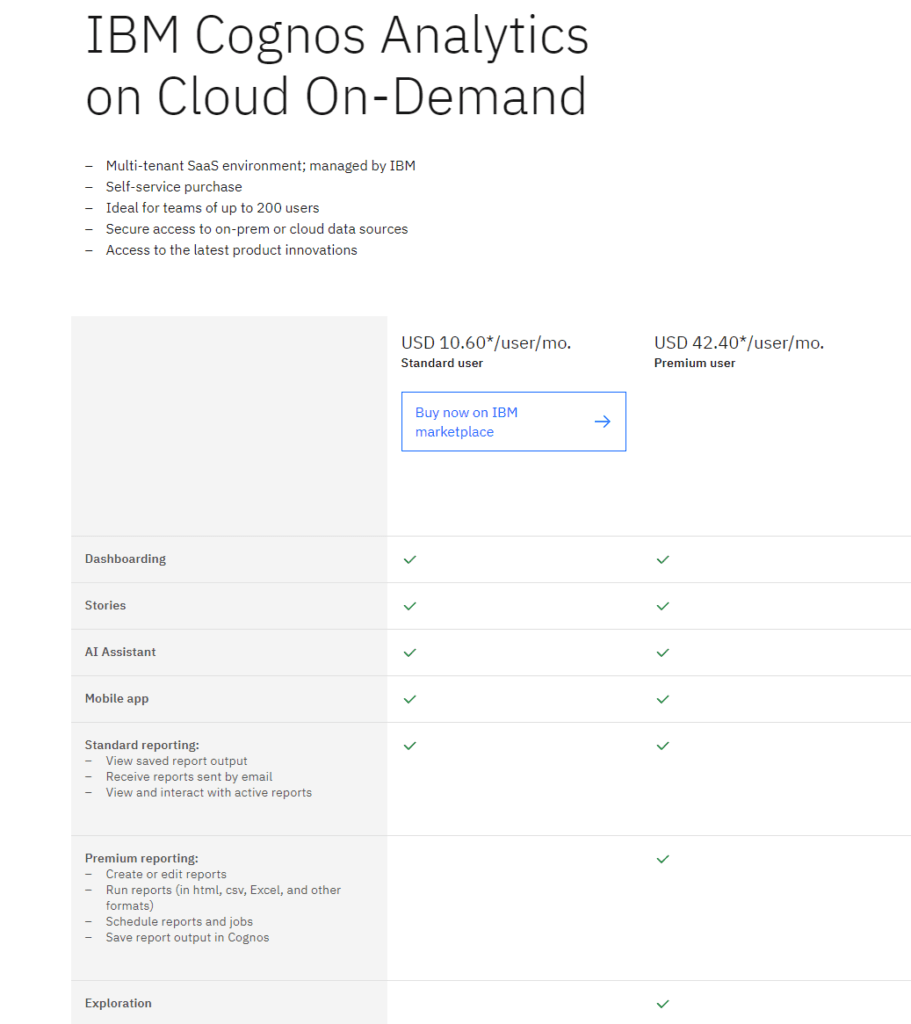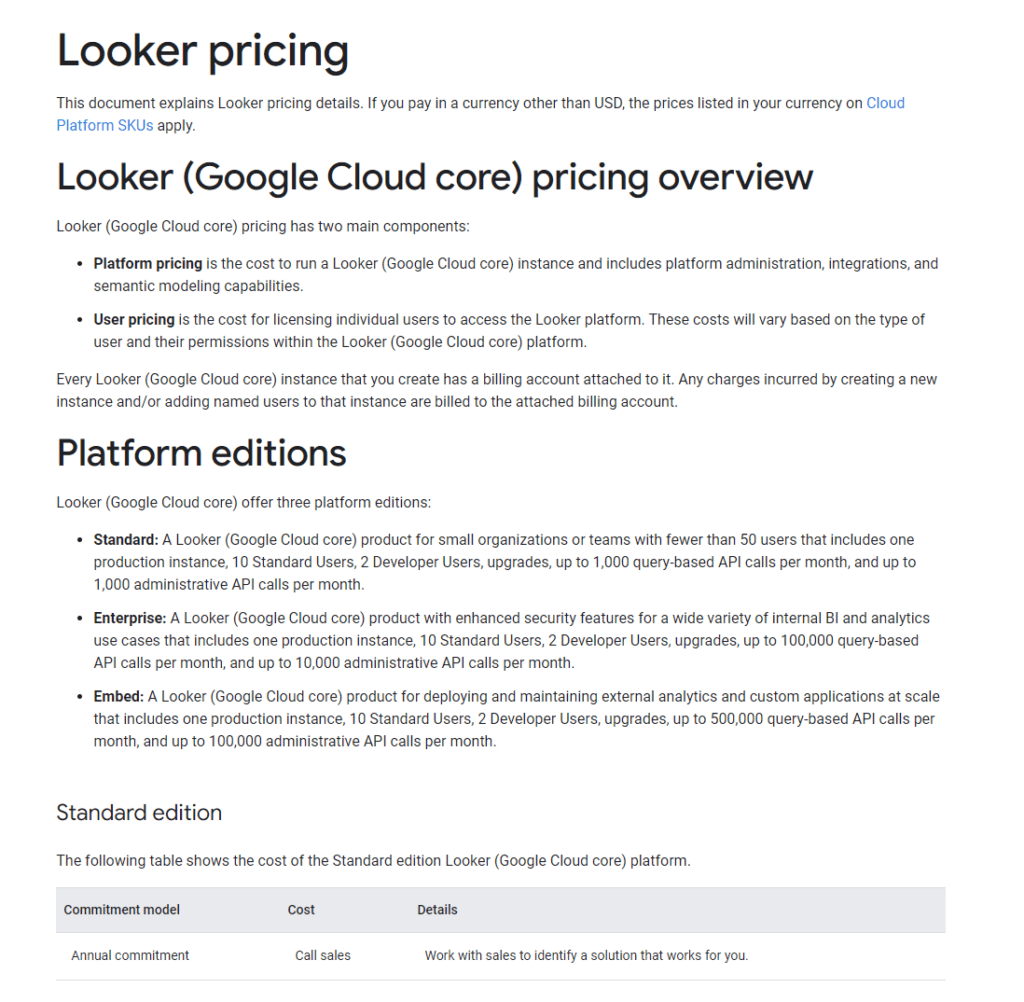In the digital age, where data-driven decisions are the backbone of successful businesses, choosing the right analytics tool isn’t just an IT decision—it’s a strategic one. With a myriad of options flooding the market, two names stand out for their robust capabilities and innovative approaches: IBM Cognos Analytics and Looker. Each platform offers unique strengths, but which one aligns with your business needs? Is it the time-tested, comprehensive IBM Cognos Analytics, known for its deep data exploration and enterprise-level reporting? Or is it Looker, with its modern, SQL-based approach and emphasis on interactive dashboards and data democratization? Dive in as we dissect these tools across critical aspects to help you pinpoint the perfect analytics companion for your journey towards data enlightenment.
| IBM Cognos Analytics | Looker |
|---|---|
 |  |
| G2 Score – 4.0 out of 5 stars | G2 Score – 4.4 out of 5 stars |
| TrustRadius Score – 8.1/10 | TrustRadius Score – 8/10 |
Data Integration and Management
In the vast sea of analytics, data integration and management serve as the compass guiding businesses toward insightful shores. How IBM Cognos Analytics and Looker handle data not only affects their ease of use but also determines the breadth and depth of insights they can provide.
IBM Cognos Analytics: The Versatile Navigator
IBM Cognos Analytics stands as a veteran in the field, known for its comprehensive approach to data integration and management. This platform is built to handle the complexity and scale of enterprise-level data ecosystems. It provides a wide array of connectors and gateways that allow organizations to bring together data from disparate sources, including traditional databases, cloud-based storage, and even unstructured data.
Once the data is within the system, Cognos offers extensive tools for cleansing, transforming, and preparing it for analysis. This ensures that the data not only becomes accessible but also reliable and structured in a way that supports deep, meaningful analysis. The strength of Cognos lies in its ability to create a unified, trusted data foundation that serves as the backbone for all analytical activities across the organization.
Looker: The Agile Explorer
On the other side, Looker, with its modern, web-based platform, offers a fresh perspective on data integration and management. At the heart of Looker’s approach is its innovative modeling language, LookML, which allows for the creation of an extensible, reusable data model that serves as a single source of truth for the organization. This model centralizes business logic, defining relationships and calculations that can be consistently applied across all analyses.
Looker integrates seamlessly with SQL-based databases, cloud data warehouses, and other modern data storage solutions, leveraging the power of these systems to perform data processing and analysis. This approach minimizes the need for extensive data movement or transformation, enabling real-time analysis and ensuring that insights are always based on the most current data. Looker’s platform empowers users to explore and analyze data with flexibility, supported by a governance framework that ensures data integrity and security.
Analytical Capabilities and Reporting Features
At the heart of any analytics tool is its ability to not only collect and organize data but to analyze and present it in a way that’s insightful and actionable. Both IBM Cognos Analytics and Looker offer robust solutions, yet they cater to different analytical appetites and presentation preferences.
IBM Cognos Analytics: The Analytical Juggernaut
IBM Cognos Analytics is akin to a seasoned cartographer, offering detailed maps (reports) and sophisticated navigational instruments (analytical tools) that can guide businesses through any data-driven journey. It’s designed for those who seek not just to navigate but to explore every nook and cranny of their data landscape. Cognos provides a comprehensive suite of analytical tools that support an array of functionalities from basic reporting to advanced analytics like predictive modeling and data mining.
The reporting features in Cognos are extensive, enabling users to create a wide range of reports, from simple lists and crosstabs to complex interactive dashboards and scorecards. These reports can be highly customized to meet the specific needs of different stakeholders within an organization. Moreover, Cognos Analytics allows for scheduled report distribution, ensuring that critical insights are delivered right to the doorstep of decision-makers, keeping everyone informed and aligned.
Looker: The Modern Explorer
Looker, on the other hand, embodies the spirit of a modern explorer, utilizing the latest tools and technologies to uncover insights. It differentiates itself with a powerful, SQL-based analytical engine and a unique modeling language, LookML, which allows for the creation of reusable data models. This approach enables businesses to maintain a single source of truth, ensuring consistency across reports and analyses. Looker’s analytical capabilities are robust, offering interactive dashboards, real-time analytics, and the ability to perform complex calculations and aggregations directly within the database.
When it comes to reporting, Looker shines with its emphasis on user-friendly, interactive dashboards that encourage data exploration. Users can easily drill down into reports, apply filters, and manipulate data on the fly to uncover deeper insights. The platform also supports a collaborative approach to analytics, enabling users to share insights and dashboards with ease, fostering a culture of data-driven decision-making across the organization.
Scalability and Performance
The scalability of an analytics tool is a testament to its ability to adapt to your organization’s growth and evolving data analysis needs. Performance, closely tied to scalability, ensures that the tool can manage larger data sets and more complex analyses efficiently, providing timely insights.
IBM Cognos Analytics: Built for the Enterprise
IBM Cognos Analytics is engineered with the needs of large enterprises in mind, making scalability one of its inherent strengths. It is designed to handle vast amounts of data and a high number of concurrent users, a necessity for organizations with extensive data analysis operations across multiple departments or geographical locations. Cognos Analytics achieves this through a distributed architecture that can efficiently balance loads, ensuring consistent performance even as demands on the system increase.
Moreover, IBM Cognos Analytics offers flexibility in deployment options, including on-premises, cloud, and hybrid models, each capable of scaling to meet the specific requirements of your organization. This adaptability ensures that as your data grows in volume and complexity, Cognos Analytics can continue to provide the robust performance and reliable insights businesses need to make informed decisions.
Looker: Agile and Cloud-Native
Looker, on the other hand, embraces a cloud-native approach, offering scalability as a core feature of its modern architecture. Its performance is optimized for the cloud, where resources can be dynamically allocated to meet the demands of data processing and analysis. This agility allows Looker to efficiently handle increases in data volume and user access, ensuring that businesses can scale their analytics operations without facing significant performance bottlenecks.
The platform’s use of powerful, in-database analytics further enhances its performance, leveraging the processing power of modern databases to execute complex queries and calculations. This approach not only speeds up data analysis but also reduces the strain on Looker’s infrastructure, enabling scalable, high-performance analytics that can grow with your organization.

Related: Check out our free SEO suite

Deployment Options and Flexibility
The choice between deployment options impacts not just the initial implementation of an analytics solution but also its ongoing management, scalability, and integration with other systems. It influences everything from data security to how quickly new features can be adopted.
IBM Cognos Analytics: Versatile and Scalable
IBM Cognos Analytics provides a broad spectrum of deployment options to accommodate the varied preferences and requirements of large enterprises. It offers the traditional on-premises deployment for organizations that prioritize full control over their analytics environment and data due to stringent security or regulatory needs. For businesses looking towards scalability and wanting to minimize the IT overhead associated with maintaining analytics infrastructure, Cognos Analytics presents cloud-based deployments.
This approach leverages IBM’s secure cloud infrastructure, offering the benefits of flexibility and scalability without the need for significant on-site hardware investments. Furthermore, for organizations that find value in both on-premises control and cloud agility, Cognos Analytics supports hybrid deployment models. This versatility ensures that businesses do not have to compromise between security and flexibility, allowing them to tailor the deployment strategy to their specific circumstances.
Looker: Cloud-Native for Agility and Innovation
Looker, designed as a cloud-native platform, emphasizes simplicity and modernity in its deployment approach. It harnesses the power and scalability of the cloud to offer businesses a quick-start solution that bypasses the complexities of on-premises installations. Looker’s cloud-based deployment accelerates the implementation process, enabling organizations to rapidly begin their data analytics journey.
The cloud infrastructure also facilitates easier access to updates and new features, ensuring that businesses can leverage the latest advancements in analytics without the need for manual upgrades. This cloud-first strategy aligns with the needs of dynamic and growing businesses that value ease of use, scalability, and the ability to adapt quickly to changing data analysis demands.
Cost and Investment
The total cost of ownership for an analytics platform encompasses not only the initial licensing or subscription fees but also the expenses related to implementation, ongoing maintenance, training, and potential customization. Balancing these costs against the expected benefits and efficiencies the platform can deliver is essential for evaluating its overall value to your organization.
IBM Cognos Analytics: Comprehensive Investment

IBM Cognos Analytics, with its expansive suite of data analytics capabilities designed for enterprise use, represents a significant investment. The platform’s pricing structure varies based on factors such as deployment options (on-premises vs. cloud), the scale of implementation, and the level of access required for different users within the organization. Enterprises must also consider the costs associated with setting up and maintaining the necessary infrastructure, especially for on-premises deployments, alongside potential expenses for custom development and advanced training to fully leverage the platform’s capabilities.
However, the investment in IBM Cognos Analytics can be justified by its comprehensive analytics offerings, which can drive substantial improvements across various business functions. For large organizations with complex analytics needs, the ROI manifests in enhanced decision-making capabilities, improved operational efficiencies, and the ability to uncover new revenue opportunities, making Cognos a strategic asset.
Looker: Agile Investment

Looker offers a different pricing model that reflects its cloud-native, modern approach to analytics. The platform’s subscription fees are typically based on the number of users and the scale of data usage, providing flexibility for businesses to scale their analytics operations as needed. The cost of Looker includes access to its powerful data exploration and visualization tools, with additional considerations for the level of customer support and training services.
The investment in Looker is often appealing to businesses focused on rapid growth and those prioritizing agility in their analytics efforts. The ROI from Looker comes in the form of accelerated insights into customer behavior, marketing performance, and product optimization, enabling quicker, data-driven decisions that can directly impact revenue and customer satisfaction.
Conclusion
IBM Cognos Analytics emerges as a robust, enterprise-grade analytics solution, designed for organizations seeking deep, comprehensive insights across various data sources and business functions. Its strengths in complex data integration, extensive customization, and broad deployment options make it a formidable tool for large enterprises with diverse and intricate analytics requirements. The platform’s commitment to scalability and performance ensures that it can support organizations as they grow, adapting to increasingly complex analytical demands.
Looker, on the other hand, represents a modern, agile approach to data analytics, prioritizing ease of use, real-time insights, and cloud-native flexibility. Its innovative use of LookML and a strong emphasis on collaborative data exploration appeal to organizations looking to democratize data access and foster a data-driven culture. Looker’s cloud-based deployment and streamlined integration capabilities make it an attractive choice for dynamic businesses focused on optimizing digital experiences and leveraging the latest in analytics technology.
Read Next:
- How to Create an SEO Plan: The Complete Guide
- How to Create a Marketing Plan: The Definitive Guide
- How CRM can Skyrocket your Customer Retention! (and Boost LTV)
- The Ultimate Guide to Digital Asset Management
- 31+ Top Social Media Management tools Compared! (2023)






















Comments are closed.